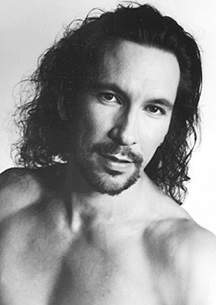Marshall Pynkoski Opera Atelier by Wah Keung Chan
/ October 1, 1998
Version française...
 Toronto’s baroque opera
company Opera Atelier is busy gearing up for its millennial production of Jean-Baptiste
Lully's opera Persée, which will open in Toronto and tour the world in the year 2000.
They finished the first phase of their training in August, running a dozen singers through
their paces. More than ever, Opera Atelier founder Marshall Pynkoski is immersed in the
recherché world of baroque performance practice, trying to reproduce the gesture and
movement of singers and actors as they were seen at the court of Louis XIV. Toronto’s baroque opera
company Opera Atelier is busy gearing up for its millennial production of Jean-Baptiste
Lully's opera Persée, which will open in Toronto and tour the world in the year 2000.
They finished the first phase of their training in August, running a dozen singers through
their paces. More than ever, Opera Atelier founder Marshall Pynkoski is immersed in the
recherché world of baroque performance practice, trying to reproduce the gesture and
movement of singers and actors as they were seen at the court of Louis XIV.Opera Atelier was founded in 1985 by artistic directors Marshall Pynkoski and
Jeannette Zingg. Pynkoski and Zingg originally danced with the Canadian Opera Company
ballet when Lotfi Mansouri was general director. "Mansouri always tried to get the
ballet involved," said Pynkoski. "That was my first experience with singers,
seeing the differences between singers' rehearsals and dancers' rehearsals. Back in the
early 1980s Jeannette and I started attending performances given by Tafelmusik. I was
intrigued with the tunes and the pitch and the enormous physicality involved in playing
authentic instruments. I became captivated with the music.”
"When Tafelmusik started moving into vocal repertoire, I found
it the most ravishing music I had ever heard, though it was often from obscure operas that
were never performed. People thought these operas were hopelessly outdated, but these same
people admitted they had never seen or heard or been involved in an opera by Charpentier
or Lully." Pynkoski decided to prove the doubters wrong by starting Canada’s
first opera company specializing in historically informed performances.
A staged Opera Atelier production involves elaborate period
costumes, baroque dancers, opera singers and Pynkoski's staging. In an address to the
National Association of Teachers of Singing in Toronto last July, Pynkoski explained his
ideas on baroque gestures.
According to Pynkoski, "The 18th century was the great age of
storytelling. Operas were word-dense and singers described their hysteria rather than
demonstrating it. People felt real emotion represents real life, and they went to the
theatre to see art, not life. If the audience saw tears on stage, they would be fascinated
rather than become drawn into the drama."
"The 18th century realized that there had to be a technique to
help singers to move that would look natural and allow them to sing comfortably and
naturally. They observed that in real life, people move when they talk, with gestures.
Gestures are from the elbows. The elbows control the arms. Movement is circular from the
hairline, and are quick, easy and articulate. The arms go only so high and so low. If the
hands are too high and extended, it is difficult for the audience to concentrate on both
the face and hands at the same time. A singer's movement must reflect the text. Individual
gestures happen on individual words and are suspended to the next important word.”
When it comes to a da capo aria, Pynkoski says that the repeat
section should be in front of the stage, "There is no reason for a da capo movement.
It's about the music. I only allow three gestures: play to the left, play to the right,
and play to the balcony."
Opera goers will get a chance to see the fruit of Pynkoski's ideas
in Opera Atelier's staging of Mozart's The Marriage of Figaro. "The opera is not just
a visual story; there is so much humour within the text. Jeremy Sams' translation for The
English National Opera caught the flavour and the raunchiness of the period. When I read
the translation, I knew I had to produce it."
Opera Atelier performs Mozart's The Marriage of Figaro in English at
Toronto's Royal Alexandra Theatre Oct. 22, 24, 27, 29, 30. Ticketing: 416-872-1212 or
1-800-461-3333.
Version française... | 

